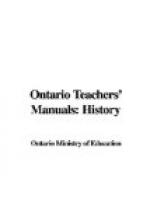In 1876 he resigned his position of Chief Superintendent, and was succeeded by a Minister of Education. He had nobly fulfilled the promise he made on accepting office in 1844—“to provide for my native country a system of education, and facilities for intellectual improvement not second to those in any country in the world.”
He died in 1882. To honour him in his death as he had served it in his life the whole country seemed assembled, in its representatives, at his funeral. Members of the Legislature, judges, University authorities, ecclesiastical dignitaries, thousands from the schools which he had founded, and above all, the common people, for whose cause he never failed to stand, followed to the grave the remains of the great Canadian who had lived so faithfully and well for his country.
NOTE.—If the pupils have been told about the Pilgrim Fathers, and the U.E. Loyalists, a review of those stories will add interest to this lesson; if not, it will serve as an introduction to them.
For a Form IV class, the following should be included in the lesson:
With the close of the War of 1812 there opened a new era in the history of Canada. Its people had realized that their country was worth fighting for, and they had defended it successfully. A new interest in its political life was awakened, new movements inaugurated. These were along three lines—one, political with responsible government as its object; another, religious with equal rights and privileges for all churches as its aim; a third, educational with equal and efficient instruction for all without distinction of class or creed as its purpose. The first movement is known as the struggle for Responsible Government—the struggle for equal political rights; the second, as the Secularization of the Clergy Reserves—the struggle for equal religious rights; the third as the University Question—the struggle for non-denominational control of education. In the second and third movements Dr. Ryerson played a very prominent part and, because these affected the politics of his day, he took a keen interest in the first.
NOTE.—For
purposes of reference, consult The Story of My
Life by Dr. Ryerson;
The Ryerson Memorial Volume by Dr. J.G.
Hodgins; Egerton
Ryerson by Nathaniel Burwash in THE MAKERS
OF CANADA; and Egerton
Ryerson by J.H. Putnam.
THE INTERCOLONIAL RAILWAY
The lesson may be begun best by referring to the provisions in the British North America Act for the building of the railway. (If the class knows nothing yet of this Act, reference may be made to Dominion Day, and the Act associated with it, by explaining the significance of the Day. The date of Confederation, 1867, may be written on the board for reference.) In the B.N.A. Act, it was provided that “the Canadian Government should build a railway connecting the St. Lawrence with Halifax, to be commenced within six months after the Union.”




